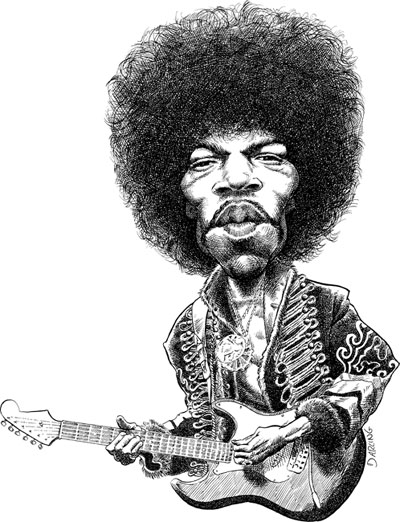by Joe Gore
More than two decades after his tunes overtly modeled after clean-toned death, Jimi Hendrix’s remarkable rhythm guitar style still grips the souls and fingers of contemporary guitar players. Steve Vai, Stevie Ray Vaughan, Eric Johnson, and others have recorded original Tunes overly modeled after clean-toned Hendrix classic like “Castles Made Of Sand” and “One Rainy Wish,” while navigating the sultry voicings of “Little Wing” remains a rite of passage for aspiring rock players, even those born well after Jimi’s demise.
Read on for the full guitar lesson complete with audio, charts, power tab and more…
Guitar Lesson
http://truefire.com/audio-guitar-lessons/jimi-hendrix-ladyland.mp3
Click here to download the Power Tab for this guitar lesson.
Hammers and Pulls
Before diving into the “(Have You Ever Been To) Electric Ladyland” transcription, test the waters with these rhythm etudes. Ex. 1, derived from the familiar E-type barre chord, demonstrates a key technique: replacing a fixed-position chord with two- and threenote voicings, freeing a finger or two to play added melodic figures. The example moves through different inversions of the A chord, adding a hammered-on non-chord tone at each stage. You can’t play it with a fixed six-note barre; instead, barre the top two strings for the first two beats. Shift your 1st finger to the 6th fret of the third string for beat 3, and then barre the fourth and fifth strings at the 7th fret for beat 4 before returning your 1st finger to the 5th fret for the final chord. This is labor-intensive stuff–three position shifts in one bar.
Finger the chord diagram shown above Ex. 2 by fretting the bass note with your thumb in true Hendrix fashion. Raising and lowering your 3rd finger introduces an added note (B, the 9 of A) situated below the standard barred A position. Now try the example. (Again, you can’t just hold down the chord in the diagram: you must continually modify your left-hand position.) Compare these added note voicings to those in Bx. 1 and try scrambling the two exercises.
Ex. 3 transports the same idea to another fretboard location. (Slide the chord in the diagram down two frets to open position you’ll see that it’s based on a barred version of an open-position G chord.) Like the previous examples, Ex. 3 is based on the A major pentatonic scale. But pentatonic scales are harmonically ambiguous: the first measure of Ex. 3 can imply A major or F# minor compare the two endings. (If you don’t understand the relationship of these two keys, consult a good theory text or teacher.)
We don’t have to restrict ourselves to pentatonic scales, of course. Ex. 4 encompasses every degree of the A major scale. (That G#/A crunch is lovely, ain’t it?) The voicing on the fourth beat of bar 1 is a stretch, but it sounds great. You’ll find it in bar 9 of “Electric Ladyland” and in the intro to the live version of “LittleWing” on The Jimi Hendrix Concerts.
Ex. 5 shows the same idea in yet another position, one that corresponds to a C-type barre chord at the 9th fret. Again, the diatonic motion can imply either A major or F# minor.
Slip Sliding
So much for hammer-ons and pull-offs what about the sliding harmonies that make Jimi’s rhythm work sound so liquid? The sliding fourths in Ex. 6 are as old as blues guitar itself (older, probably they sound distinctly African). At any rate, they’re an R&B staple.
The sliding fourths in Ex. 7 are situated higher on the neck. Ex. 6 and Bx. 7 are 100% pentatonic, so they suit many chord sequences in both A major and F#’ minor. ‘By playing them over these progressions: A-D, A7-D7,A-F#m, F#m-D7, and F#m7-Bm7.
The sliding fifths in Ex. 8 sound a bit weirder. Try replicating them in other positions and across three strings (for example, play the first notes of the example at the first string, 12th fret and third string, 14th fret, damping the second string).
Jimi often fattened these open fifths with lower notes. Adding a lower third creates the minor 7th chord fragments shown in Ex. 9. The Bm7 and F#m7 are built from the same harmony, but situated on different strings. Play the low F# with your thumb. (This voicing appears in bar 7 of “Electric Ladyland.“)
Now things get curiouser and curiouser. Adding a fifth below the fifth creates a sonorous, but harmonically ambiguous, structure-the first chord in Ex. 10 can imply Gadd9, Em11, C13, Am11, and other chords. (A favorite of Andy Summers, this stack-o’-fifths powered many a Police hit.) Hendrix often reinforced the lowest note by fretting it an octave below with his thumb, sometimes adding an open third-string drone, as shown in the second measure. Slide this chord up and down the neckyou’ll be playing the “Castles Made Of Sand” intro before you know it.
You’ll find all these techniques in “Electric Ladyland,” a tune that contains some of Hendrix’s most bizarre extensions of these concepts. Harmonic, rhythmic, and melodic weirdness abounds: The chord progression sidles though several keys via clever enharmonic tricks; the rhythms often imply 3/4 time (though it’s notated in strict 4/4 for simplicity’s sake): and the oddball solo emphasizes the dissonant 7th more than the tonic. The falsetto vocals are a zonked-out tip of the hat to the Impressions, and the twin guitars do-s&do from foreground to background (though most of the techniques we’ve covered are played by the first guitar). It’s notated in A, but Jimi tuned down a half-step to Ab. Chords that are merely implied are indicated in parentheses.
The transcription comes from Hal Leonard Publications’ Electric Ladyland transcription book, which, together with their Are You Experienced? and Axis, Bold As Love volumes are the finest Hendrix transcriptions available (despite a shocking number of music typos). Finally, don’t miss the solo guitar version of “Electric Ladyland” on Hal Leonard’s Jimi Hendrix: Rhythm instructional CD. Have at it.
